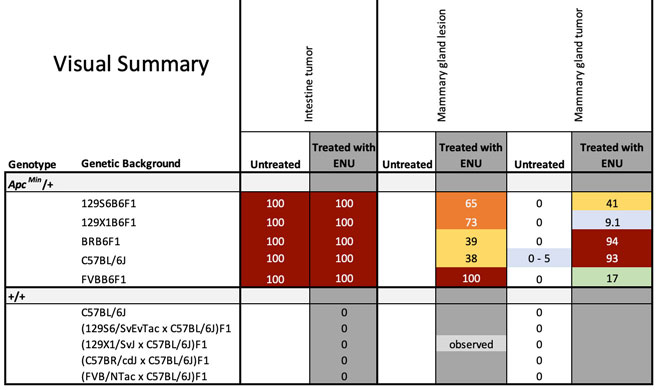Reference SummaryMoser AR, Cancer Res 2001 Apr 15;61(8):3480-5
Title |
Genetic background affects susceptibility to mammary hyperplasias and carcinomas in Apc(min)/+ mice. | ||||||||||||||||||
Authors |
Moser AR; Hegge LF; Cardiff RD | ||||||||||||||||||
Journal |
Cancer Res | ||||||||||||||||||
Volume |
61 | ||||||||||||||||||
Issue |
8 | ||||||||||||||||||
Year |
2001 | ||||||||||||||||||
Pages |
3480-5 | ||||||||||||||||||
Abstract |
Treatment of female C57BL/6J (B6) mice carrying the mutant Min allele of the adenomatous polyposis coli (Apc) gene with ethylnitrosourea (ENU) results in approximately 90% of mice developing an average of three mammary tumors within 65 days. As a first step in the identification of loci modifying susceptibility to ENU-induced mammary tumors and hyperplasias, we have tested ENU-treated Apc(Min)/+ (Min/+) mice on several hybrid backgrounds for susceptibility to mammary and intestinal tumors. C57BR/cdJxB6 (BRB6) Min/+ mice were more sensitive to development of mammary squamous cell carcinomas than B6 Min/+ mice. In contrast, Min/+ hybrids between B6 and FVB/NTac (FVB), 129X1/SvJ (129X1), and 129S6/SvEvTac (129S6) were all significantly more resistant to mammary carcinoma development. However, mice from these three crosses developed more focal mammary hyperplasias than did the B6 or BRB6 Min/+ mice. Susceptibility to intestinal tumors was independent of mammary tumor susceptibility in most hybrids. These results indicate that genetic background can affect independently the phenotypes conferred by the Min allele of APC: | ||||||||||||||||||
Links |
J:68915 – MGI References 11309311 – National Library of Medicine/PubMed |
||||||||||||||||||
Strain Notes
|
|||||||||||||||||||

| |||||||||||||||||||
| Strain | Model Name | Treatment Agent(s) | Organ Affected | Frequency | Model Details |
|---|---|---|---|---|---|
| C57BL/6J-ApcMin/+ | Intestine tumor | Intestine |
100 |
||
| C57BL/6J-ApcMin/+ | Intestine tumor |
|
Intestine |
100 |
|
| C57BL/6J | Intestine tumor |
|
Intestine |
0 |
|
| BRB6F1-ApcMin/+ | Intestine tumor |
|
Intestine |
100 |
|
| BRB6F1-ApcMin/+ | Intestine tumor | Intestine |
100 |
||
| (C57BR/cdJ x C57BL/6J)F1 | Intestine tumor |
|
Intestine |
0 |
|
| 129S6B6F1-ApcMin/+ | Intestine tumor |
|
Intestine |
100 |
|
| 129S6B6F1-ApcMin/+ | Intestine tumor | Intestine |
100 |
||
| (129S6/SvEvTac x C57BL/6J)F1 | Intestine tumor |
|
Intestine |
0 |
|
| 129X1B6F1-ApcMin/+ | Intestine tumor |
|
Intestine |
100 |
|
| 129X1B6F1-ApcMin/+ | Intestine tumor | Intestine |
100 |
||
| (129X1/SvJ x C57BL/6J)F1 | Intestine tumor |
|
Intestine |
0 |
|
| FVBB6F1-ApcMin/+ | Intestine tumor |
|
Intestine |
100 |
|
| FVBB6F1-ApcMin/+ | Intestine tumor | Intestine |
100 |
||
| (FVB/NTac x C57BL/6J)F1 | Intestine tumor |
|
Intestine |
0 |
|
| C57BL/6J-ApcMin/+ | Mammary gland lesion |
|
Mammary gland |
38 |
|
| BRB6F1-ApcMin/+ | Mammary gland lesion |
|
Mammary gland |
39 |
|
| 129S6B6F1-ApcMin/+ | Mammary gland lesion |
|
Mammary gland |
65 |
|
| 129X1B6F1-ApcMin/+ | Mammary gland lesion |
|
Mammary gland |
73 |
|
| (129X1/SvJ x C57BL/6J)F1 | Mammary gland lesion |
|
Mammary gland |
observed |
|
| FVBB6F1-ApcMin/+ | Mammary gland lesion |
|
Mammary gland |
100 |
|
| C57BL/6J-ApcMin/+ | Mammary gland tumor | Mammary gland |
0 - 5 |
||
| C57BL/6J-ApcMin/+ | Mammary gland tumor |
|
Mammary gland |
93 |
|
| C57BL/6J | Mammary gland tumor | Mammary gland |
0 |
||
| BRB6F1-ApcMin/+ | Mammary gland tumor |
|
Mammary gland |
94 |
|
| BRB6F1-ApcMin/+ | Mammary gland tumor | Mammary gland |
0 |
||
| (C57BR/cdJ x C57BL/6J)F1 | Mammary gland tumor | Mammary gland |
0 |
||
| 129S6B6F1-ApcMin/+ | Mammary gland tumor |
|
Mammary gland |
41 |
|
| 129S6B6F1-ApcMin/+ | Mammary gland tumor | Mammary gland |
0 |
||
| (129S6/SvEvTac x C57BL/6J)F1 | Mammary gland tumor | Mammary gland |
0 |
||
| 129X1B6F1-ApcMin/+ | Mammary gland tumor |
|
Mammary gland |
9.1 |
|
| 129X1B6F1-ApcMin/+ | Mammary gland tumor | Mammary gland |
0 |
||
| (129X1/SvJ x C57BL/6J)F1 | Mammary gland tumor | Mammary gland |
0 |
||
| FVBB6F1-ApcMin/+ | Mammary gland tumor |
|
Mammary gland |
17 |
|
| FVBB6F1-ApcMin/+ | Mammary gland tumor | Mammary gland |
0 |
||
| (FVB/NTac x C57BL/6J)F1 | Mammary gland tumor | Mammary gland |
0 |